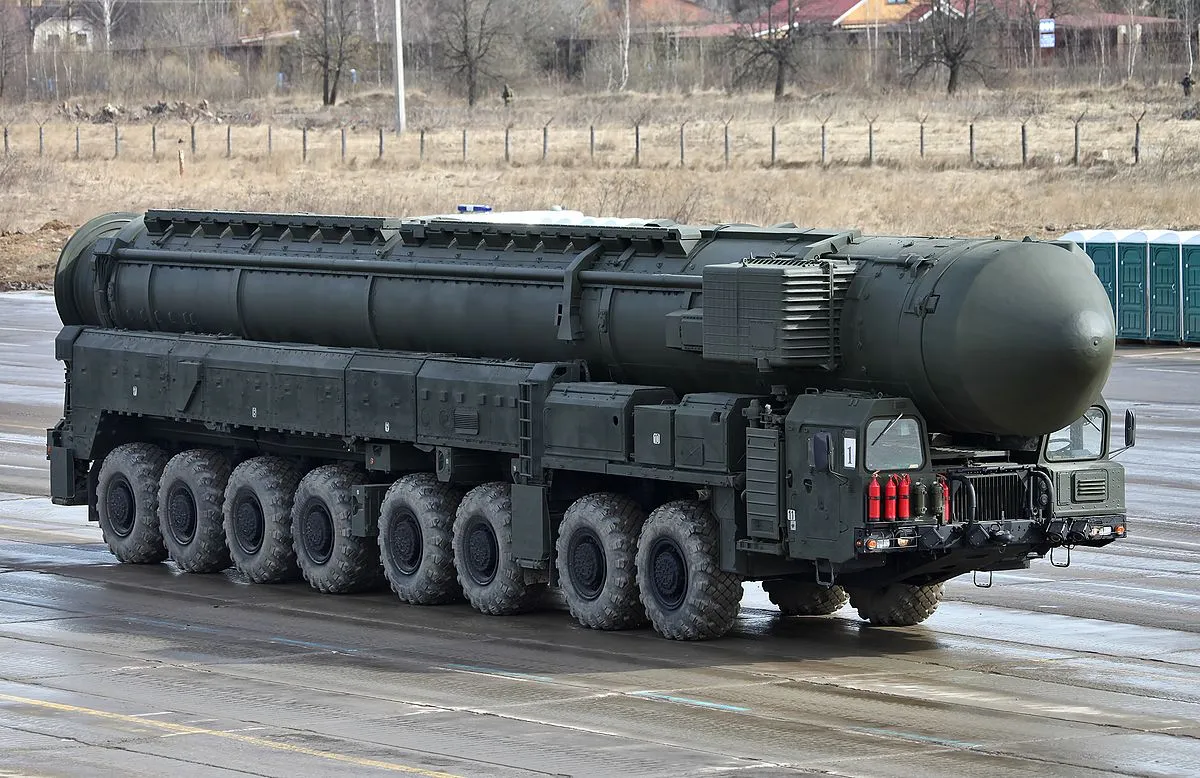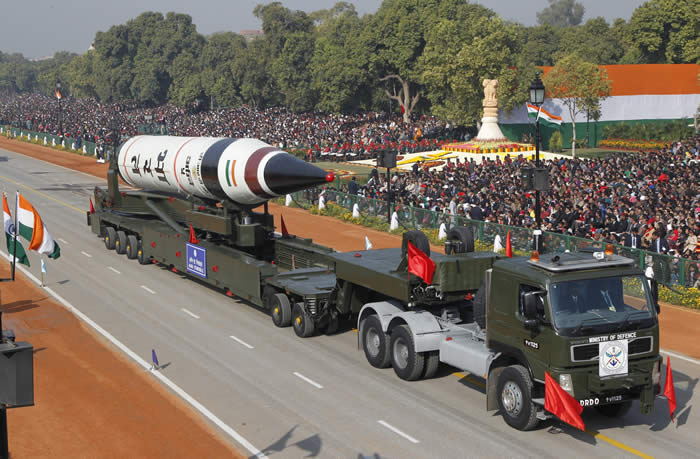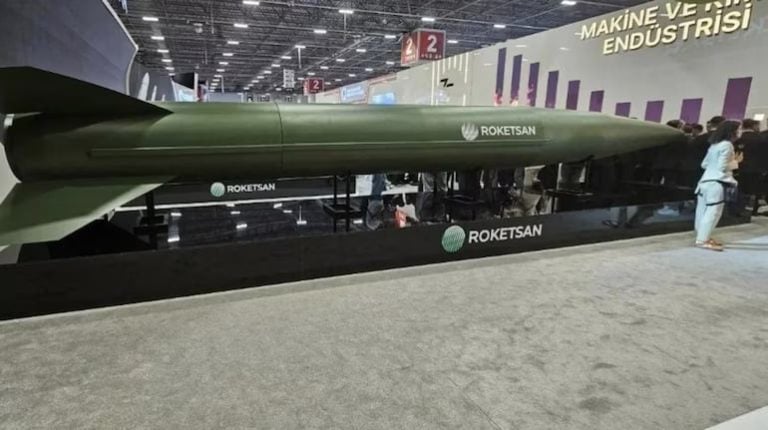Intercontinental ballistic missiles represent the ultimate expression of military power in today’s world. These fearsome weapons have reshaped global strategic calculations through their ability to deliver nuclear warheads across continents in just 30 minutes or less. With ranges exceeding 5,500 kilometers, ICBMs stand as both the most sophisticated weapons technology and the backbone of nuclear deterrence strategies worldwide.
Russia’s RS-28 Sarmat stands as the most powerful ICBM currently deployed, earning its Western nickname “Satan 2” through sheer destructive potential. This colossal missile boasts an 18,000-kilometer range and can carry up to 15 nuclear warheads, making it virtually impossible to intercept with current defense systems. China’s DF-41 presents another formidable threat with its impressive 14,000-kilometer reach, allowing Beijing to target any location in Europe or North America within 20 minutes of launch. Meanwhile, the United States relies on the aging but remarkably reliable LGM-30 Minuteman III system, which has maintained America’s land-based nuclear deterrent since the 1970s with its 13,000-kilometer range.
The competition for ICBM supremacy continues unabated across major powers. While Russia advances development of next-generation systems like the Sarmat, the United States maintains overwhelming firepower through a two-pronged approach. The US strategic arsenal includes 405 Minuteman-III ICBMs distributed across three heavily-fortified bases, complemented by the Navy’s 14 Ohio-class submarines carrying 288 Trident II missiles. Each submarine-launched Trident can deliver multiple independently-targetable warheads at ranges up to 12,000 kilometers, creating an almost invulnerable second-strike capability.
India has quietly joined this exclusive club with its Agni-V system. Though receiving less international attention, this indigenous missile with its 5,000-8,000 kilometer range significantly alters the strategic landscape in Asia since becoming operational in 2021. The Agni-V provides India with the capability to target locations throughout China, fundamentally changing regional power dynamics.
Also Read | Hypersonic Missiles: The Future of Warfare
RS-28 Sarmat (Russia)
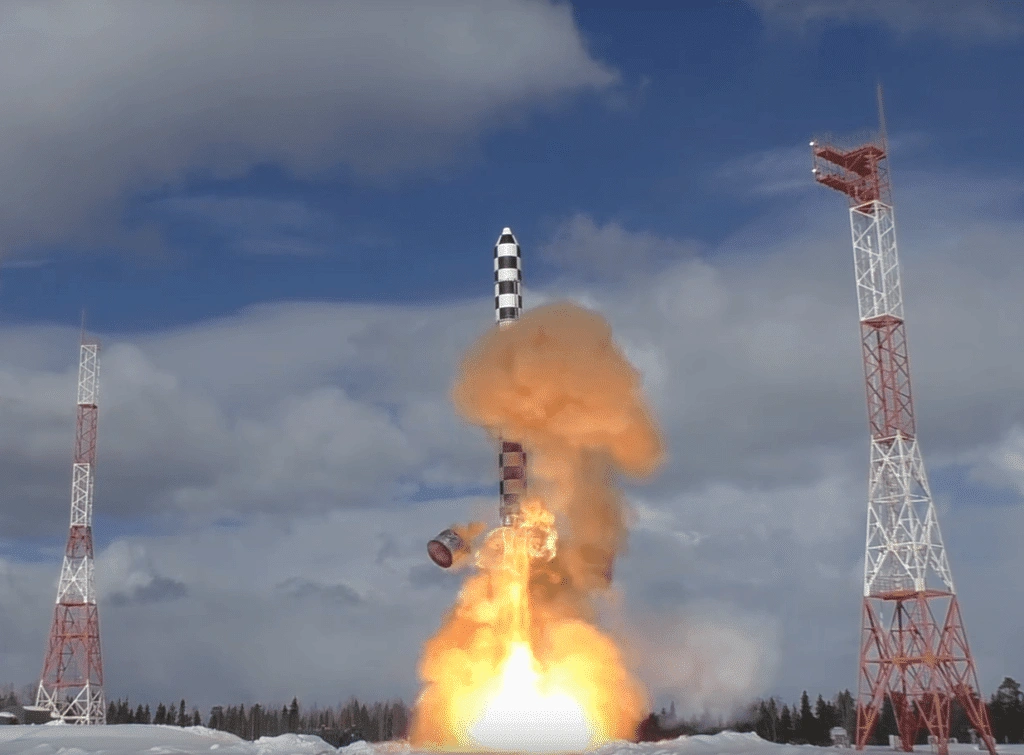
The RS-28 Sarmat stands as Russia’s premier next-generation nuclear deterrent, developed to replace the aging Soviet-era R-36M2 Voyevoda ICBMs. Western intelligence agencies and media outlets quickly dubbed this behemoth “Satan 2” – a name that speaks volumes about its perceived threat. Development began in the early 2000s, with Russia awarding production contracts to Makeyev Design Bureau and NPOMash in 2011. The missile officially entered operational service in September 2023, though its deployment journey has been marked by significant technical challenges and testing setbacks.
RS-28 Sarmat specifications
The Sarmat boasts extraordinary dimensions that set it apart from virtually all other operational ICBMs. This silo-based system employs a three-stage, liquid-fueled design that enables its unprecedented capabilities.
| Specification | Details |
|---|---|
| Length | 35.3 meters |
| Diameter | 3.0 meters |
| Launch weight | 208,100 kg |
| Propulsion | Three-stage, liquid-fueled |
| Class | Heavy Intercontinental Ballistic Missile |
| NATO designation | SS-X-30 |
| Alternate name | Satan II |
| Basing | Silo-based |
The RS-28 incorporates several advanced engineering elements that enhance its effectiveness. Its booster casing features an orthogrid structure that simultaneously reduces weight and improves structural integrity. The missile’s propulsion system likely utilizes a derivative of the existing RD-274 engine, with test footage revealing a distinctive four-nozzle configuration during first-stage propulsion. Additionally, the Sarmat employs a “cold launch” system where pressurized gas ejects the missile from its silo before main engine ignition, preserving the launch facility for potential reuse.
RS-28 Sarmat range and payload
The Sarmat’s range capabilities are nothing short of extraordinary. With a maximum reach of 18,000 kilometers, this missile can effectively target any location on Earth. During its first publicized test on April 20, 2022, the system reportedly traveled 6,000 kilometers to the Kura test range in Kamchatka in approximately 20 minutes – demonstrating both speed and accuracy.
The missile’s payload capacity is equally impressive, exceeding 10 tons and offering exceptional versatility. Russian military sources indicate the Sarmat can carry:
- Up to 10 heavy nuclear warheads
- Up to 16 smaller warheads
- A combination of warheads and penetration aids
- Multiple Avangard hypersonic boost-glide vehicles
This massive throw weight serves dual strategic purposes – hedging against potential improvements in US missile defense systems while delivering three times the MIRV capacity of Russia’s solid-fueled RS-24 Yars system. The ability to deploy multiple hypersonic glide vehicles further complicates any potential interception efforts.
RS-28 Sarmat deployment status
Despite Russia’s official claims, the RS-28 Sarmat’s operational status remains questionable. The system’s troubled development history began with a prototype completion in late 2015, followed by silo ejection tests between December 2017 and May 2018. However, numerous delays plagued the program.
The first full flight test occurred on April 20, 2022 – years behind schedule. Russian President Vladimir Putin announced the missile’s operational deployment with the Strategic Missile Forces in December 2022, and Roscosmos head Yuri Borisov claimed the system had achieved “combat duty” status by September 2023.
These assertions appear increasingly dubious in light of recent events. The missile reportedly suffered a catastrophic failure during its latest test on September 21, 2024. This follows at least one other failed flight test and two canceled tests since the initial 2022 launch. While Russia continues efforts to deploy the Sarmat, the timeline remains uncertain given these persistent technical challenges.
Current plans call for deployment with the 13th Red Banner Rocket Division at Dombarovsky Air Base and the 62nd Red Banner Rocket Division at Uzhur, replacing the Soviet-era R-36M ICBMs currently stationed at these locations.
Also Read | How Russia’s Nuclear Forces Compare to NATO’s Arsenal
RS-28 Sarmat strategic impact
The RS-28 Sarmat holds tremendous strategic significance for Russia’s nuclear deterrence posture. As a cornerstone of Russia’s nuclear triad, the missile incorporates specific design elements to defeat advanced missile defense systems through a combination of speed, maneuverability, and countermeasures.
One key advantage lies in the missile’s short initial boost phase, which minimizes the window when enemy surveillance systems can track the launch. President Putin has specifically highlighted this feature, noting it reduces the period when American Space-Based Infrared System satellites can detect the missile’s heat signature.
Perhaps most concerning to Western defense planners is the Sarmat’s Fractional Orbital Bombardment capability. This allows the missile to fly a trajectory over the South Pole to strike targets in the United States, effectively bypassing missile defense systems concentrated in the northern hemisphere. The system also incorporates the ‘Mozyr’ active protection suite, designed to neutralize potential first-strike advantages by adversaries.
While Russia maintains a diverse nuclear arsenal, silo-based ICBMs like the Sarmat occupy a crucial position due to their massive payload capacity and strategic role in the nuclear deterrence equation. Despite ongoing technical difficulties, the RS-28 represents a potentially formidable advancement that could reshape the strategic balance between major powers for decades to come.
LGM-30G Minuteman III (USA)
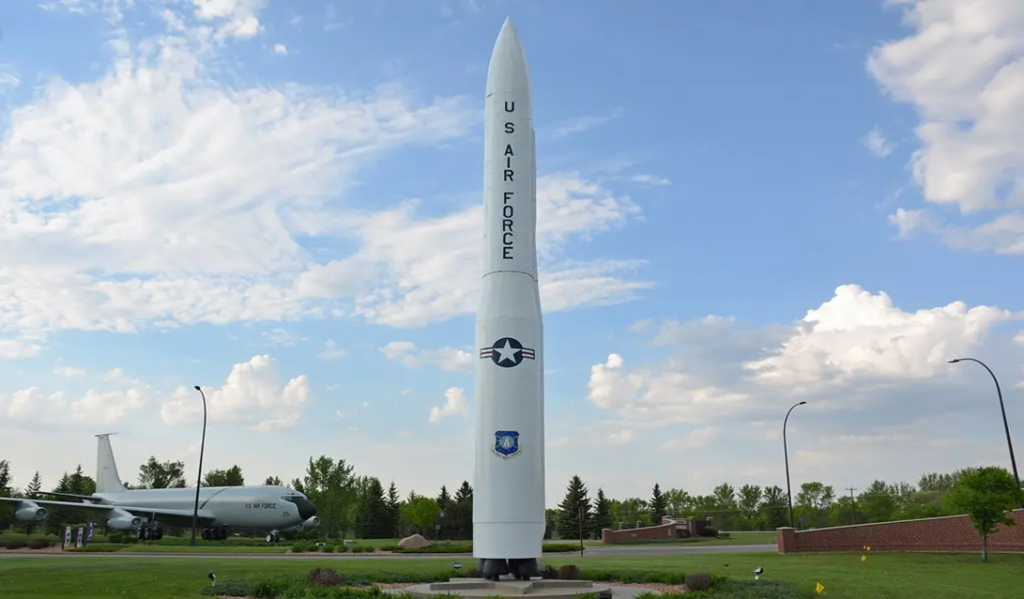
The LGM-30G Minuteman III serves as the backbone of America’s land-based nuclear deterrent and represents a critical component of the U.S. nuclear triad. This solid-fueled ICBM first entered service in June 1970 and has maintained its strategic role for over five decades. Despite numerous modernization efforts throughout its service life, the missile remains fundamentally unchanged in its core design – a testament to its exceptional engineering and reliability. The Air Force currently prepares to replace these aging missiles with the LGM-35A Sentinel system, ensuring America maintains a credible land-based nuclear deterrent well into the future.
LGM-30G Minuteman III specifications
The Minuteman III uses a three-stage solid-propellant design that offers significant advantages over liquid-fueled alternatives, particularly in terms of maintenance requirements and rapid launch capability.
| Specification | Details |
|---|---|
| Length | 18.2 meters (59.9 feet) |
| Diameter | 1.67 meters (5.5 feet) |
| Launch weight | 36,030 kilograms (79,432 pounds) |
| Propulsion | Three solid-propellant rocket motors |
| First stage thrust | 203,158 pounds |
| Second stage thrust | 60,793 pounds |
| Third stage thrust | 35,086 pounds |
| Max speed | Approximately 24,000 km/h (15,000 mph) at burnout |
| Ceiling | 1,120 kilometers (700 miles) |
The missile’s three-stage propulsion system incorporates solid-fuel rockets manufactured by ATK, including a refurbished M55A1 first stage, SR-19 second stage, and SR-73 third stage. This configuration delivers exceptional acceleration, significantly reducing the missile’s vulnerability to enemy interception during the critical boost phase.
LGM-30G Minuteman III range and payload
The Minuteman III boasts impressive range capabilities that place virtually any target on Earth within its reach. With a maximum range exceeding 13,000 kilometers (8,100 miles), though officially listed as “6,000-plus miles” (approximately 9,700 kilometers), this ICBM can strike targets across continents within 30 minutes of launch.
In terms of payload, the Minuteman III made history as the world’s first missile to carry Multiple Independently Targetable Reentry Vehicles (MIRVs). While originally designed to deliver three separate warheads, each missile has been limited to a single warhead since 2005 under international treaty agreements. Current warhead options include:
- W78 warhead with yield of 335-350 kilotons
- W87 warhead with yield of 300 kilotons
The missile’s guidance system has undergone several upgrades throughout its service life, improving its accuracy from an original Circular Error Probable (CEP) of about 200 meters to approximately 120 meters – precision that ensures target destruction even with a single warhead.
LGM-30G Minuteman III deployment status
The U.S. currently maintains a force of 400 operational Minuteman III missiles, strategically distributed across three Air Force bases:
- 90th Missile Wing at F.E. Warren AFB, Wyoming
- 341st Missile Wing at Malmstrom AFB, Montana
- 91st Missile Wing at Minot AFB, North Dakota
Each missile resides in a hardened underground silo designed to withstand nuclear attack. These silos connect to underground Launch Control Centers (LCCs) through hardened cable systems, with launch crews of two officers maintaining constant 24/7 alert status, ready to execute presidential launch commands.
The system features remarkable redundancy through specially configured E-6B airborne launch control center aircraft that can automatically assume command of isolated missiles should ground communication be disrupted. This insurance policy ensures launch orders can be executed even in worst-case scenarios where ground-based command centers are destroyed.
Also Read | The Nuclear Triad: America’s Ultimate Defense Strategy
LGM-30G Minuteman III strategic impact
The Minuteman III embodies a different philosophy than Russia’s RS-28 Sarmat, emphasizing reliability and proven performance over raw destructive power. Its key strategic advantages include:
- Nearly 100 percent testing reliability
- Rapid launch capability (approximately 60 seconds from order to launch)
- Widely dispersed basing that complicates enemy targeting
- Backup airborne launch controllers that preserve retaliatory capabilities
Throughout its five decades of service, the Minuteman III has undergone extensive modernization efforts. These include the Guidance Replacement Program that updated its original computer systems with radiation-resistant semiconductor RAM, improved solid rocket fuel formulations, and enhanced electrical power systems.
The Air Force is now preparing for the future with the Ground-Based Strategic Deterrent (GBSD) program, now designated the LGM-35A Sentinel. This replacement system successfully completed its integrated baseline review around April 2021 and should achieve initial operational capability by 2029. Until then, the venerable Minuteman III continues its vigilant service as America’s land-based nuclear guardian.
DF-41 (China)
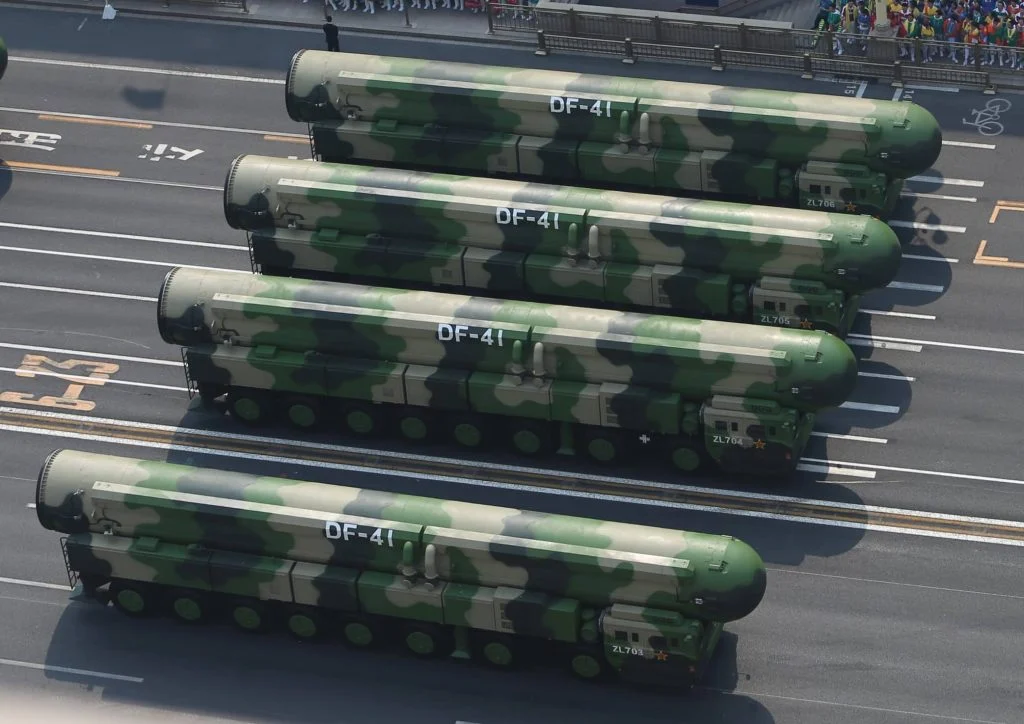
The DF-41 stands as China’s most formidable nuclear weapon system, representing a quantum leap in Beijing’s strategic capabilities. First unveiled during China’s 70th anniversary military parade in 2019, this fourth-generation ICBM has rapidly altered the nuclear balance in Asia and beyond. Development of this powerful system began as early as July 1986 as part of China’s prestigious Dongfeng (“East Wind”) missile series. Between 2012 and 2018, the missile underwent a rigorous testing regimen, with analysts documenting six to eight flight tests prior to its operational deployment.
DF-41 specifications
The technical parameters of the DF-41 place it among the most sophisticated ICBMs currently deployed anywhere in the world:
| Specification | Details |
|---|---|
| Chinese/US designation | DF-41 / CSS-X-10 |
| Length | 20-22 meters |
| Diameter | 2.25 meters |
| Launch weight | 80,000 kg |
| Propulsion | Three-stage, solid propellant |
| Guidance system | Inertial with stellar/satellite updates |
| Accuracy (CEP) | Approximately 100 meters |
| Basing options | Road-mobile, rail-mobile, silo-based |
It’s important to note that unlike many of Russia’s liquid-fueled missiles, the DF-41’s solid propellant design offers critical strategic advantages. This configuration provides enhanced reliability, significantly reduced maintenance requirements, and dramatically faster deployment times – all essential qualities for a survivable nuclear deterrent. The missile’s relatively compact dimensions further enhance its versatility, allowing for multiple basing options that complicate enemy targeting efforts.
DF-41 range and payload
The DF-41’s exceptional range capabilities represent one of its most significant strategic advantages. With a maximum reach of 12,000-15,000 kilometers, this system stands as China’s longest-range missile. This impressive capability allows operators to target virtually any location in the continental United States from secure positions within mainland China.
The missile’s payload capacity is equally remarkable. Carrying an estimated payload weight of 2,500 kg, the DF-41 can reportedly deploy up to 10 multiple independently-targetable reentry vehicles (MIRVs), each with its own nuclear warhead. However, most defense analysts believe a typical warhead configuration likely includes fewer MIRVs complemented by various penetration aids specifically designed to overwhelm and confuse missile defense systems.
Also Read | Nuclear Triad: The Three Pillars of Strategic Deterrence
DF-41 deployment status
After several decades of development, the DF-41 transitioned from testing to limited production around 2019. China’s decision to display sixteen DF-41 launchers during its 70th anniversary parade on October 1, 2019, served as a clear confirmation of the system’s operational status and its importance to China’s strategic posture.
The primary deployment platform for the DF-41 is road-mobile, utilizing the massive Tian HTF5980 special wheeled chassis with its distinctive 16×16 wheel configuration. This impressive vehicle provides substantial cross-country mobility across various terrain types while remaining optimized for hard-surface roads. Beyond road-mobile capabilities, mounting evidence suggests China has developed both rail-mobile and silo-based variants to create a more diverse and survivable deterrent force.
Current intelligence assessments indicate China maintains at least 20 operational DF-41 missiles, likely organized into two brigades as suggested by Chinese sources during the 2019 parade. More concerning for Western defense planners, satellite imagery from November 2022 confirmed that China continues constructing additional silos specifically designed for housing DF-41 ICBMs, signaling a significant expansion of this capability.
DF-41 strategic impact
The DF-41 presents formidable challenges for adversaries attempting to neutralize China’s nuclear deterrent. Its combination of extreme range, MIRV capability, and diverse deployment options makes it extraordinarily difficult to track, target, or intercept – precisely the qualities needed for a credible nuclear deterrent.
China’s road-mobile DF-41 units exploit an extensive network of tunnels and underground facilities, emerging only during crisis situations to move to remote, pre-surveyed launch positions. The rail-mobile variant creates even more complex tracking challenges, as launchers can be disguised as ordinary passenger trains, utilize China’s expanding high-speed rail network, and exploit tunnels to evade satellite surveillance.
Perhaps most significantly, China has dramatically accelerated construction of hardened silos for DF-41 missiles, with U.S. intelligence identifying approximately 120 new silos in Gansu province alone. This expansion represents the largest growth in China’s land-based nuclear capabilities in history, fundamentally altering strategic calculations between major powers.
The technical sophistication of the DF-41 – particularly its MIRV warheads – provides China with an enhanced ability to overwhelm missile defense systems, thereby strengthening its nuclear deterrence posture against the United States and other nuclear powers. As China continues to expand its DF-41 force, the strategic landscape in Asia and beyond will continue to evolve, forcing adjustments in defense planning across the region.
UGM-133 Trident II (USA/UK)
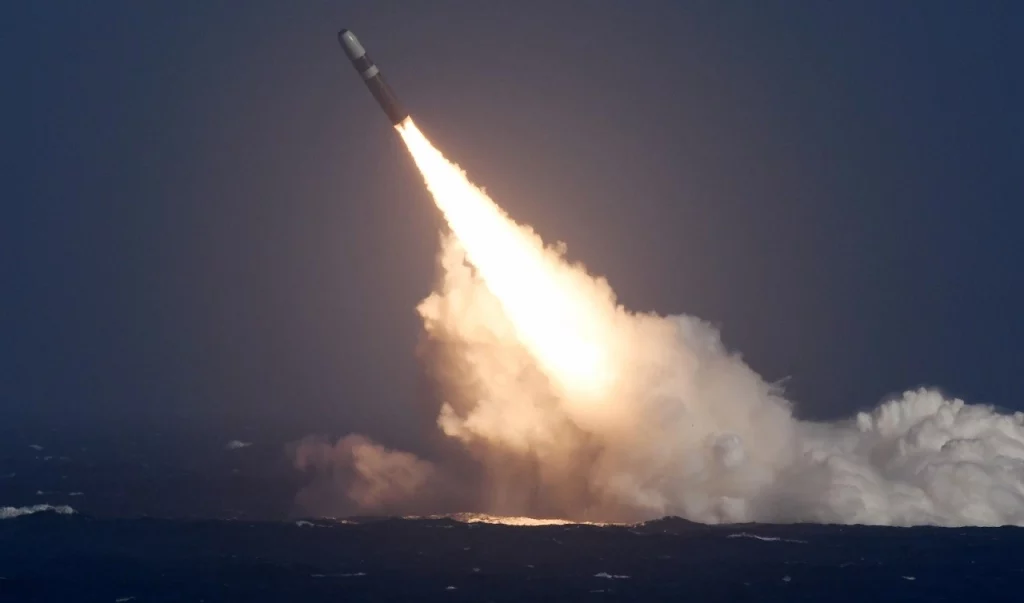
The UGM-133 Trident II D5 stands as the most formidable submarine-launched ballistic missile in the Western arsenal, serving as the cornerstone of sea-based nuclear deterrence for both the United States and United Kingdom. First deployed in March 1990, this remarkable weapon system has established an unparalleled record of reliability with over 190 successful test launches—a feat unmatched by any competitor system. The Trident II represents the most survivable leg of America’s nuclear triad, complementing land-based ICBMs with mobile launch platforms that remain virtually undetectable beneath the ocean’s surface.
UGM-133 Trident II specifications
The Trident II combines exceptional engineering with compact design, enabling its deployment from submarine launch tubes while maintaining impressive performance capabilities:
| Specification | Details |
|---|---|
| Length | 13.42 m (44 ft 6.6 in) |
| Diameter | 2.11 m (6 ft 11 in) |
| Launch weight | 59,090 kg (130,000 lbs) |
| Propulsion | Three-stage solid propellant |
| Guidance system | Inertial with stellar reference update |
| Accuracy (CEP) | 90 meters |
| Manufacturer | Lockheed Martin Space |
| Unit cost | Approximately $37.5 million (2019) |
Unlike many competing systems, the Trident II features graphite epoxy construction throughout all three rocket stages. This advanced material significantly reduces weight compared to traditional metal-based designs, directly contributing to the missile’s extended range and enhanced payload capacity.
UGM-133 Trident II range and payload
The Trident II delivers extraordinary reach with a maximum range of 12,000 kilometers (7,500 miles), allowing submarines to engage targets virtually anywhere on Earth from their patrol areas. This impressive range persists even when carrying multiple warheads, though specific performance figures vary based on payload configuration and flight trajectory.
The missile’s Post-Boost Vehicle (PBV) provides exceptional flexibility in warhead deployment, capable of carrying:
- 8 MIRV Mk-5 warheads equipped with W88 (475 kt yield)
- 12 MIRV Mk-4/Mk-4A warheads with W76-0 (100 kt yield) or W76-1 (90 kt yield)
- Low-yield W76-2 (5-7 kt) warheads for tactical applications
In actual deployment, arms control agreements limit the number of warheads per missile, with the New START treaty capping deployable warheads at eight per missile. This limitation, however, does nothing to diminish the system’s tremendous destructive potential.
UGM-133 Trident II deployment status
The Trident II currently serves aboard 14 U.S. Ohio-class submarines and 4 British Vanguard-class submarines. Each American vessel carries 20 missiles (reduced from 24 to comply with New START provisions), while each British submarine maintains 16 missiles.
The system’s reliability stands as its most impressive attribute. Since design completion in 1989, the Trident II has conducted 191 successful test flights. Across all testing scenarios, including both sea and land launches, the system has achieved 207 successes from 215 total launches—a 96% success rate that inspires extraordinary confidence in this critical deterrent.
Both nations have committed to maintaining the Trident II well into mid-century. The U.S. launched the D5 Life Extension Program in 2002, systematically replacing aging components with commercial off-the-shelf hardware to maintain performance while controlling costs. Simultaneously, both countries are developing next-generation submarines—the Columbia-class for America and the Dreadnought-class for Britain—specifically designed to carry Trident II missiles through the 2050s.
Also Read | Nuclear Submarines: The Ultimate Deterrent
UGM-133 Trident II strategic impact
The Trident II represents the most critical strategic asset in the Western nuclear arsenal. Its unmatched combination of accuracy, range, and survivability makes it the ultimate second-strike weapon, ensuring retaliatory capability even after an enemy’s first strike.
From a strategic perspective, submarine-launched missiles like the Trident II fundamentally alter deterrence calculations by creating permanent uncertainty for potential adversaries. Unlike fixed land-based missile silos that can be targeted, submarines remain hidden in the vastness of the world’s oceans, making a disarming first strike essentially impossible.
The missile’s exceptional payload flexibility allows both nations to adjust their strategic posture as international conditions evolve. When combined with its remarkable reliability record, these attributes ensure the Trident II will remain the bedrock of Western nuclear deterrence for decades to come—the silent guardian that makes nuclear conflict unwinnable and therefore unlikely.
RS-24 Yars (Russia)
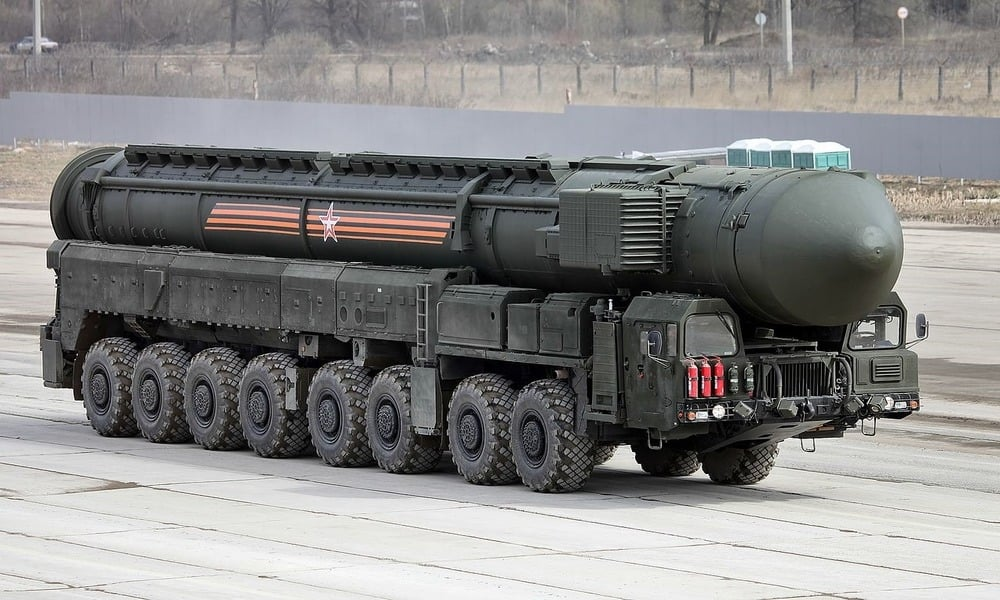
The RS-24 Yars stands as one of Russia’s most formidable nuclear deterrents, first entering combat service in 2010. Essentially a MIRVed evolution of the older Topol-M system, this deadly missile represents a significant advancement in Russia’s strategic arsenal. Designed by the Moscow Institute of Thermal Technology, the Yars offers remarkable deployment flexibility, available in both road-mobile and silo-based configurations that provide Russia with diverse strategic options.
RS-24 Yars specifications
The technical parameters of the RS-24 Yars establish it among Russia’s most potent nuclear delivery systems:
| Specification | Details |
|---|---|
| Russian/NATO designation | RS-24 Yars/SS-29 or SS-27 Mod 2 |
| Length | 22.5 meters |
| Diameter | 2.0 meters |
| Launch weight | 49,600 kg |
| Propulsion | Three-stage solid-fueled |
| Guidance system | Inertial with possible GLONASS (satellite) updates |
| Accuracy (CEP) | 100-250 meters |
| Maximum speed | Mach 25 (30,600 km/h) |
| Basing options | Road-mobile, silo-based |
RS-24 Yars range and payload
The Yars delivers exceptional striking capability with an operational range between 10,500-12,000 kilometers, enabling it to target locations across continents with devastating effect. Some sources indicate the missile maintains effectiveness from a minimum range of 2,000 kilometers all the way to its maximum reach of 12,000 kilometers.
The missile’s payload capacity features Multiple Independently targetable Reentry Vehicles (MIRVs), with varying estimates of its carrying capacity:
- Most conservative estimates suggest three to four warheads
- More aggressive assessments indicate up to ten MIRVs
- Each warhead delivers a devastating nuclear yield of 150-300 kilotons
RS-24 Yars deployment status
Russia has actively deployed both variants of the RS-24 Yars as part of its strategic modernization efforts. Intelligence estimates from November 2019 indicated “more than 150” operational launchers, with this number likely expanding to approximately 204 missiles by the close of 2023.
The system’s rapid response capability represents a key tactical advantage, requiring only seven minutes to prepare for launch. Russia’s commitment to strategic modernization continues unabated, with the country reportedly receiving “around 20” new Yars complexes annually, steadily enhancing its nuclear capabilities.
RS-24 Yars strategic impact
The RS-24 Yars provides Russia with significant strategic advantages that place it among the deadliest weapons in their arsenal. Its sophisticated flight characteristics, including the ability to maneuver during trajectory and deploy both active and passive countermeasures, present substantial challenges for even the most advanced missile defense systems.
Mobile variants exploit Russia’s extensive road network, creating a constantly moving target that proves exceptionally difficult to track and neutralize. Combined with hardened silo-based counterparts, the RS-24 Yars forms a critical component of Russia’s nuclear deterrence strategy. Military analysts expect the system to remain in active service for approximately two more decades, continuing to shape strategic calculations across the globe.
Also Read | Russia’s Nuclear Modernization Program: What You Should Know
Agni-V (India)
India’s entry into the exclusive club of nations possessing intercontinental ballistic missile technology marked a decisive shift in the strategic balance of Asia. The Agni-V, developed by the Defense Research and Development Organization (DRDO), represents a significant breakthrough in the country’s indigenous defense capabilities. First tested in April 2012 from Abdul Kalam Island off Odisha’s coast, this missile system stands as a testament to India’s growing military technological prowess.
Agni-V specifications
The Agni-V incorporates sophisticated engineering features that place it among advanced strategic weapons globally:
| Specification | Details |
|---|---|
| Length | 17.5 meters |
| Diameter | 2.0 meters |
| Launch weight | 50,000–56,000 kg |
| Propulsion | Three-stage solid-fueled |
| Guidance system | Ring Laser Gyro-based Inertial Navigation |
| Maximum speed | Estimated ~Mach 24 (approx. 29,400 km/h) |
| Basing | Road-mobile (canisterized launch) |
| Launch platform | Transporter Erector Launcher (TEL) |
The missile’s “canisterized” design provides substantial operational advantages. This sealed container approach not only reduces maintenance requirements but also dramatically shortens launch preparation time. When deploying, the system utilizes a cold-launch mechanism where pressurized gas ejects the missile from its container before the main rockets ignite, enhancing survivability of the launch platform.
Agni-V range and payload
The Agni-V delivers impressive performance parameters critical for credible nuclear deterrence. While official statements typically cite a range of 5,000-5,500 kilometers, defense analysts assess the actual reach extending to 7,000-8,000 kilometers with reduced payload configurations. This extended range brings the entirety of China and portions of Europe within striking distance from Indian territory.
In terms of payload capacity, the missile can deliver a nuclear warhead weighing between 1,500-1,650 kilograms. Most significantly, recent developments have enhanced its strategic value:
- Successful MIRV capability demonstration in March 2024 (Mission Divyastra)
- Ability to deploy multiple warheads against different targets from a single missile
- Implementation of penetration aids to defeat missile defense systems
Former DRDO Director Dr. V.K. Saraswat aptly described this MIRV capability as a “force multiplier” for India’s strategic deterrence posture.
Agni-V deployment status
The Agni-V has followed a methodical development path since its maiden test in 2012. Subsequent tests in 2013, 2015, 2016, and 2018 demonstrated progressive refinements to the system. A significant milestone occurred in January 2015 when testing transitioned from open launching to the more militarily practical canister-based deployment.
Following successful user trials, India’s Strategic Forces Command formally inducted the system around 2019. The most recent advancement came with the successful test of the MIRV-capable variant in March 2024 under the codename Mission Divyastra. Defense Minister Rajnath Singh subsequently confirmed the operational deployment of this enhanced system, placing India among the select nations possessing this sophisticated technology.
Agni-V strategic impact
The Agni-V fundamentally alters strategic calculations in Asia for several reasons. First and foremost, its range enables coverage of the entire Chinese mainland, including densely populated eastern coastal regions and military installations. This capability provides India with a credible deterrent against its northern neighbor and primary regional competitor.
The missile’s MIRV technology introduces an additional dimension by enabling simultaneous engagement of multiple targets. This capability complicates enemy defense planning and enhances the missile’s ability to penetrate ballistic missile defenses through a combination of multiple warheads and decoys.
Beyond these technical advantages, the Agni-V represents a cornerstone of India’s nuclear triad alongside submarine-launched and air-delivered weapons. Looking ahead, reports indicate development of an even more capable Agni-VI with range potentially exceeding 10,000 kilometers. Such a system would extend India’s strategic reach across Europe, Asia, Africa, Oceania, and parts of North America, firmly establishing the country as a global strategic power.
Also Read | Indian Navy’s Nuclear Submarine Program: A Deep Dive
Hwasong-17 (North Korea)
!Image
Image Source: ABC News
North Korea’s Hwasong-17 stands as perhaps the most concerning addition to global ICBM arsenals in recent years. Proudly labeled by Pyongyang as the “world’s strongest strategic weapon,” this massive missile first appeared publicly during a military parade in October 2020. Its emergence represents a quantum leap in North Korea’s strategic capabilities and has triggered significant alarm among defense analysts worldwide due to its potential to deliver nuclear warheads to targets throughout the continental United States.
Hwasong-17 specifications
The sheer physical dimensions of the Hwasong-17 set it apart from other ICBMs. It holds the distinction of being the largest road-mobile, liquid-fueled ICBM currently operational anywhere in the world.
| Specification | Details |
|---|---|
| Length | 24-26 meters |
| Diameter | 2.4-2.5 meters |
| Mass (fueled) | 80,000-110,000 kg |
| Propulsion | Two-stage, liquid-fueled |
| Launch platform | 11-axle Transporter Erector Launcher (TEL) vehicle |
| Guidance system | Inertial |
| Warhead type | Likely multiple reentry vehicles (MIRVs) – nuclear capable |
The missile’s massive size creates significant transportation challenges, requiring an enormous 11-axle transporter-erector-launcher (TEL) vehicle to move it. This mobility, despite its size, presents unique tracking and targeting problems for adversaries.
Hwasong-17 range and payload
Japanese Defense Minister Yasukazu Hamada has estimated the Hwasong-17’s maximum range at approximately 15,000 kilometers – sufficient to target any location within the continental United States. Test flights have demonstrated the missile’s impressive performance envelope, with recorded altitudes reaching 6,000 kilometers while traveling roughly 1,000 kilometers horizontally.
The missile’s payload capacity is equally concerning. Defense analysts believe it can deliver a warhead weighing between 2,000-3,500 kg. More troubling still, the Hwasong-17’s substantial diameter suggests it may be designed to eventually accommodate multiple independently targetable reentry vehicles (MIRVs). This capability would allow a single missile to carry 3-4 separate nuclear warheads targeting different locations, drastically increasing its strategic threat.
Hwasong-17 deployment status
Since its public unveiling in 2020, North Korea has conducted several test launches of the Hwasong-17. The regime claimed its first successful test on March 24, 2022, though South Korean intelligence sources disputed this assertion. However, subsequent tests on November 18, 2022, and March 16, 2023, have been confirmed by international observers.
Current intelligence estimates suggest North Korea maintains approximately 11 operational Hwasong-17 missiles. These weapons represent the most advanced delivery systems for North Korea’s estimated arsenal of 55 nuclear warheads, produced from approximately 70kg of enriched nuclear material.
Hwasong-17 strategic impact
The strategic implications of the Hwasong-17 extend far beyond its technical specifications. Kim Jong Un has explicitly described the missile as demonstrating “North Korea’s resolve and ability to eventually build the world’s strongest army.” Beyond such rhetoric, the missile presents genuine challenges for existing missile defense systems.
Perhaps most concerning is the system’s potential MIRV capability. If fully developed, this technology would allow North Korea to overwhelm American missile defense systems by deploying multiple warheads and decoys from a single missile. Defense analysts warn that even a small number of Hwasong-17 launches could saturate and penetrate United States defensive measures.
The Hwasong-17 thus represents a significant evolution in North Korea’s strategic arsenal – one that forces military planners in Washington, Seoul, and Tokyo to recalculate their defensive postures and response options in the event of regional conflict.
Also Read | How Missile Defense Systems Work Against Modern ICBMs
Comparison of World’s Deadliest ICBMs (2025)
Understanding the true balance of power between nuclear states requires a direct comparison of their most formidable weapons systems. The table below presents a comprehensive analysis of the seven deadliest ICBMs currently deployed, highlighting their key technical specifications and operational capabilities. This side-by-side examination reveals significant differences in design philosophy, technological capabilities, and strategic applications across nuclear powers.
| Missile Name | Country | Length (m) | Diameter (m) | Launch Weight (kg) | Range (km) | Propulsion Type | Warhead Capacity | Current Deployment |
|---|---|---|---|---|---|---|---|---|
| RS-28 Sarmat | Russia | 35.3 | 3.0 | 208,100 | 18,000 | Three-stage liquid | Up to 15 warheads | Limited operational deployment |
| LGM-30G Minuteman III | USA | 18.2 | 1.67 | 36,030 | 13,000 | Three-stage solid | Single warhead (post-2005) | 400 operational missiles |
| DF-41 | China | 20-22 | 2.25 | 80,000 | 12,000-15,000 | Three-stage solid | Up to 10 MIRVs | At least 20 operational |
| UGM-133 Trident II | USA/UK | 13.42 | 2.11 | 59,090 | 12,000 | Three-stage solid | Up to 8-12 MIRVs | 14 US + 4 UK submarines |
| RS-24 Yars | Russia | 22.5 | 2.0 | 49,600 | 10,500-12,000 | Three-stage solid | 3-10 MIRVs | ~204 missiles |
| Agni-V | India | 17.5 | 2.0 | 50,000-56,000 | 5,000-8,000 | Three-stage solid | MIRV capable | Operational |
| Hwasong-17 | North Korea | 24-26 | 2.4-2.5 | 80,000-110,000 | 15,000 | Two-stage liquid | 2,000-3,500 kg payload | At least 11 missiles |
Several key observations emerge from this comparative analysis. Russia’s RS-28 Sarmat stands out for its sheer size and throw-weight, dwarfing all other systems with a launch weight exceeding 200,000 kg. By contrast, the American Minuteman III represents a different design philosophy, emphasizing reliability and deployment numbers over raw destructive power. The Trident II system, shared between the US and UK, offers exceptional accuracy with a CEP of just 90 meters, making it particularly effective for precision strikes against hardened targets.
China’s DF-41 and North Korea’s Hwasong-17 both present significant challenges to missile defense systems through their range capabilities and potential MIRV configurations. Meanwhile, India’s Agni-V, while possessing the shortest range of the missiles listed, remains sufficient to target all strategically relevant locations within its primary regional competitor, China.
Most notable is the clear trend toward solid-propellant systems, with only Russia’s Sarmat and North Korea’s Hwasong-17 using liquid fuel. This reflects the operational advantages of solid-fuel missiles, which offer enhanced reliability, reduced maintenance requirements, and faster launch preparation times.
Also Read | The New Arms Race: Hypersonic Weapons Development
Conclusion
The modern era of intercontinental ballistic missiles has fundamentally reshaped global power dynamics and military strategy. These seven deadly systems we’ve examined represent the ultimate expression of strategic deterrence across major nuclear powers. The technical capabilities and deployment status of these weapons directly influence international relations and defense policies worldwide.
Russia’s RS-28 Sarmat stands out as perhaps the most physically imposing system in existence. With its towering 35.3-meter length and extraordinary 18,000-kilometer range, this colossal weapon theoretically allows Moscow to strike any point on Earth. However, the system’s deployment challenges and testing failures have significantly limited its operational effectiveness, raising questions about Russia’s ability to field this next-generation weapon in meaningful numbers.
The United States has taken a different approach, maintaining strategic stability through a two-pronged nuclear deterrent. The aging but remarkably reliable Minuteman III system continues to serve as America’s land-based nuclear backbone, while the submarine-launched Trident II missiles provide a nearly invulnerable second-strike capability. This combination creates a formidable deterrent that compensates for the Minuteman’s relatively modest specifications through sheer reliability and dispersed deployment.
China’s DF-41 deserves particular attention for its operational flexibility and significant MIRV capabilities. By deploying this system in road-mobile, rail-mobile, and silo-based configurations, Beijing has created a weapon that’s exceptionally difficult to track and target. The missile’s ability to carry up to 10 nuclear warheads provides China with unprecedented strategic reach against American assets and those of its regional allies.
India’s Agni-V, though less discussed in international security circles, represents a profound shift in regional power dynamics. Its MIRV capability and extended range fundamentally alter the strategic calculus between India and China, giving New Delhi credible deterrence against its powerful northern neighbor for the first time. The system’s continued development suggests India’s determination to secure its place among global nuclear powers.
Russia’s RS-24 Yars offers similar capabilities to the DF-41 through a more mature, field-tested platform. With approximately 204 missiles deployed across mobile and silo-based launchers, this system forms the backbone of Russia’s land-based nuclear forces and will likely remain so for decades to come.
North Korea’s Hwasong-17, while technologically less sophisticated than its Western or Chinese counterparts, nevertheless represents a significant strategic challenge. Its estimated 15,000-kilometer range theoretically places the entire continental United States within striking distance—a capability Pyongyang has long sought to achieve. Despite uncertainties about its reliability and accuracy, the missile’s massive dimensions and substantial payload capacity make it a weapon that Western defense planners cannot afford to ignore.
These advanced systems continue to shape international relations through their mere existence rather than actual use. Their primary purpose remains deterrence—preventing conflict by ensuring any nuclear attack would face devastating retaliation. Understanding these weapons provides crucial insight into current geopolitical dynamics and the strategic calculations made by world powers. As missile defense technologies evolve alongside offensive capabilities, the balance between these deadly systems will ultimately determine global strategic stability for decades to come.
FAQs
Q1. What is currently considered the most powerful ICBM in the world?
The RS-28 Sarmat, developed by Russia, is widely regarded as the most powerful ICBM. It has an unprecedented range of 18,000 kilometers, can carry up to 15 nuclear warheads, and travels at hypersonic speeds, making it extremely difficult to intercept.
Q2. How does India’s Agni-V missile compare to other global ICBMs?
The Agni-V is India’s most advanced ICBM, with a range of 5,000-8,000 kilometers. While not as long-ranged as some other ICBMs, it is MIRV-capable and provides India with the ability to strike targets across most of Asia, significantly altering regional strategic balance.
Q3. Which country currently possesses the largest number of ICBMs?
As of 2025, Russia maintains the largest ICBM arsenal, with an estimated 306 strategic missiles capable of carrying up to 1,185 nuclear warheads. This gives Russia significant strategic deterrence capabilities on the global stage.
Q4. What makes the DF-41 ICBM particularly significant for China’s military capabilities?
The DF-41 is China’s most advanced ICBM, featuring a range of 12,000-15,000 kilometers and the ability to carry up to 10 MIRVs. Its diverse deployment options, including road-mobile, rail-mobile, and silo-based variants, enhance its survivability and strategic flexibility.
Q5. How has North Korea’s development of the Hwasong-17 ICBM impacted global security concerns?
The Hwasong-17, North Korea’s largest ICBM, has raised significant international concerns due to its estimated 15,000-kilometer range, potentially allowing it to strike targets throughout the continental United States. Its large payload capacity and potential for future MIRV capability present new challenges for missile defence systems.
